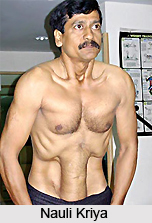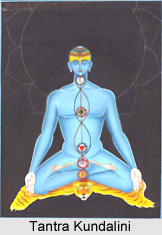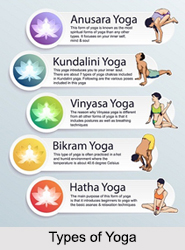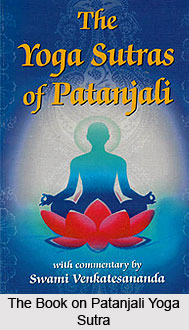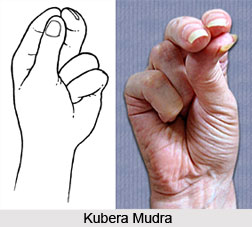The regimens used by the top athletes can be combined into batteries for specific purposes. Some of the examples are as follows:
Supplemental Exercise for Athletes
 The advantages of these exercises for home practices as with all yoga asanas, are low demand on space, time and equipment. This battery positively affects the mental state, process of recovery, improves the elasticity of the spine, relaxes the muscles and benefits the cardiovascular system and other organs and body functions. Athletes can practise the following asanas:Modified Paschimottanasana, Bhujangasana, Dhanurasana, Sarvangasana, Halasana, Matsyasanaand Shavasana.
The advantages of these exercises for home practices as with all yoga asanas, are low demand on space, time and equipment. This battery positively affects the mental state, process of recovery, improves the elasticity of the spine, relaxes the muscles and benefits the cardiovascular system and other organs and body functions. Athletes can practise the following asanas:Modified Paschimottanasana, Bhujangasana, Dhanurasana, Sarvangasana, Halasana, Matsyasanaand Shavasana.
Asanas to Prevent or Rehabilitate Back Pain
This set of asanas consists of selected and modified yoga asanas for both strengthening the abdominal and hip extensor muscles and stretching the lower back and hip flexor muscles. They include: Salabhasana, Modified Halasana, Modified Half and Salabhasana
Asanas for Relaxing Tired Legs after Intensive Workout
The following set of yoga asanas speeds up the process of regeneration (elimination of the products of fatigue) by applying pull, rotation, pressure and the force of gravity. This increases the flexibility and elasticity of the leg muscles and ligaments. These asanas are:
Modified Padmasana, Modified Bhadrasana, Sarvangasana, Prasarita Padottanasana, Modified Vajrasana, Garudasana and Shavasana.
 Asanas for Improving Balance & Concentration
Asanas for Improving Balance & Concentration
The following asanas develop balance and concentration, besides many other benefits. When assuming one of the balance postures, first choose a focus point to gaze at. This will facilitate assuming and balancing the posture. Athletes can incorporate one or two asanas into their daily training regimen, both for improving the sense of balance and concentration. These asanas are: Natarajasana, Mayurasanaand Garudasana.
Specific Activating Asanas
Given below are some of the examples of asanas and techniques, which activate, or mobilize and stimulate and tone the body. In general, rapid, strong breath (inhalation), open eyes and leaning the trunk backward all have an activating effect. These asanas are: Bhujangasana, Salabhasana, Dhanurasana, Modified Sarvangasana, Modified Ardha Matsyendrasana, Mayurasana, Uddiyana Bandha and Kapalabhati.
Specific De-activating Asanas
Given below are the examples of the techniques, which de-activate the body and have a relaxing or calming effect. In general deep, slow, long exhalation, closed eyes and leaning the trunk forward, all have a calming effect. These are: Modified Padahasthasana, Paschimottanasana, Halasana, Matsyasana and Shavasana.
Asanas for Stimulation (Activation)
Bhujangasana, Salabhasana and Dhanurasana
Asanas for Calming (De-activation)
During the competition, when the athletes want to decrease their level of activation, and get into a deep, relaxed state, they should practise these asanas at the right time. The best time to do these are about 5-6 minutes after finishing their physical-warm up exercises. This deep relaxation should always be followed by a series of short reactivation exercises in order to once again reach an optimal level of activation. Sometimes, it is necessary to go through another warm-up, if ever there is a long pause in the competition. Athletes should however, plan these additional warm-ups, so that they reach the desired state of preparedness without wasting a lot of their energy. Each warm-up set should be individual and sport specific. These asanas are: Modified Sarvangasana, Halasana and Matsyasana.
 Asanas for Gymnastics
Asanas for Gymnastics
These sports affect all the muscles of the body. Hence, asanas, which develop the muscles of the trunk and abdomen, would be useless for the gymnasts. These athletes need to concentrate on asanas that affect the spine to prevent the development of the so called "gymnastic back," a deformation of the spine. For the gymnasts, hence the suggested asanas are given as follows: Bhujangasana, Dhanurasana, Prasarita Padottanasana, and Modified Ardha Matsyendrasana.
Asanas for Boxing
Boxing has many side effects on the body of the athlete, effectively developing the respiratory system in addition to its strength. However, supplementary exercises are useful to assure optimum health. A complete yoga training with a focus on asanas effecting the spine as well as asanas developing a sense of balance are recommended. Also, the practice of Raja Yoga optimizes reaction time and especially, facilitates the combination of punch and quick decision-making. Thus, the suggested asanas for the same are those that affect the spine and develop a sense of balance, such as: Bhujangasana, Dhanurasana, Prasarita Padottanasana, Modified Ardha Matsyendrasana, Salabhasana, Halasana and Mayurasana.
Asanas for Swimming, Aquatic Sports
These are the most valuable sports from the aspect of Yoga. In the water, the swimmer uses regulative, rhythmic breathing, just as in yoga. Thus, for the swimmers, the following asanas for increasing the flexibility of the shoulder joints and for stretching the lower back are suggested: Prasarita Padottanasana, Bhujangasana, Modified Dhanurasana, Modified Ardha Matsyendrasana, Natarajasana and Salabhasana.
 Asanas for Wrestling & Judo, Karate
Asanas for Wrestling & Judo, Karate
These sports harmoniously develop the muscles of the whole body; therefore less supplemental training is required. Thus, for the wrestlers and judo or karate athletes, the suggested asanas are as follows: Bhujangasana, Dhanurasana, Salabhasana, Modified Ardha Matsyendrasana, Prasarita Padottanasana and Paschimottanasana.
Asanas for Weightlifting
This sport does not sufficiently develop the pulmonary system. The weight lifters experience the dilation of capillaries and also fallen arches. Thus yoga can also help combat these problems. Thus, for such athletes, the suggested asanas are as follows:
Asanas in reverse position to prevent dilation of capillaries: Sarvangasana, Modified Sarvangasana, Sirsasana.
Sitting asanas and specific exercises to strengthen the muscles of the feet: Shavasana and Modified Padmasana.
To stretch the muscles of the back, legs, chest and stomach: Modified Paschimottanasana, Bhujangasana, Dhanurasana, Halasana, Modified Ardha Matsyendrasana, Prasarita Padottanasanaand Padasana variation "B".
Asanas for Tennis & Racquet Sports
 These ports belong in the one-sided sports category. Heavy use of the racquets can cause muscle dysbalances. Therefore, complex yoga training is recommended as supplemental and compensational training. These athletes need to focus on asanas that strengthen the lower back and improve the flexibility of the shoulder and knee joints. The suggested asanas are: Prasarita Padottanasana, Bhujangasana, Salabhasana, Modified Dhanurasanaand Modified Gomukhasana.
These ports belong in the one-sided sports category. Heavy use of the racquets can cause muscle dysbalances. Therefore, complex yoga training is recommended as supplemental and compensational training. These athletes need to focus on asanas that strengthen the lower back and improve the flexibility of the shoulder and knee joints. The suggested asanas are: Prasarita Padottanasana, Bhujangasana, Salabhasana, Modified Dhanurasanaand Modified Gomukhasana.
Asanas for Walking and Running
Simple cyclical movements like walking or running are "one-sided" from the aspects of harmonious development. Therefore, complex yoga training as supplement exercises is recommended. Thus, the suggested asanas are as follows:
Asanas with reverse position and which affect the spine for the prevention of the pain in the lower back.
The set of asanas for both rehabilitating the lower back and prevention of pain and injury are: Modified Sarvangasana, Sarvangasana and Sirsasana.
Asanas, which stretch the muscles of the thigh, calf and ankle, are: Janu Sirsasana, Natarajasanaand Paschimottanasana.




